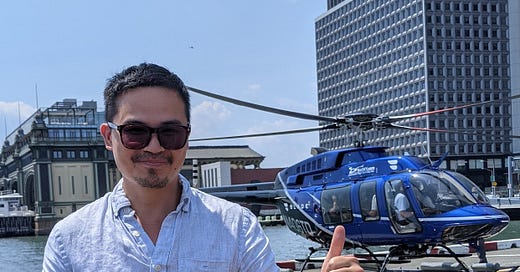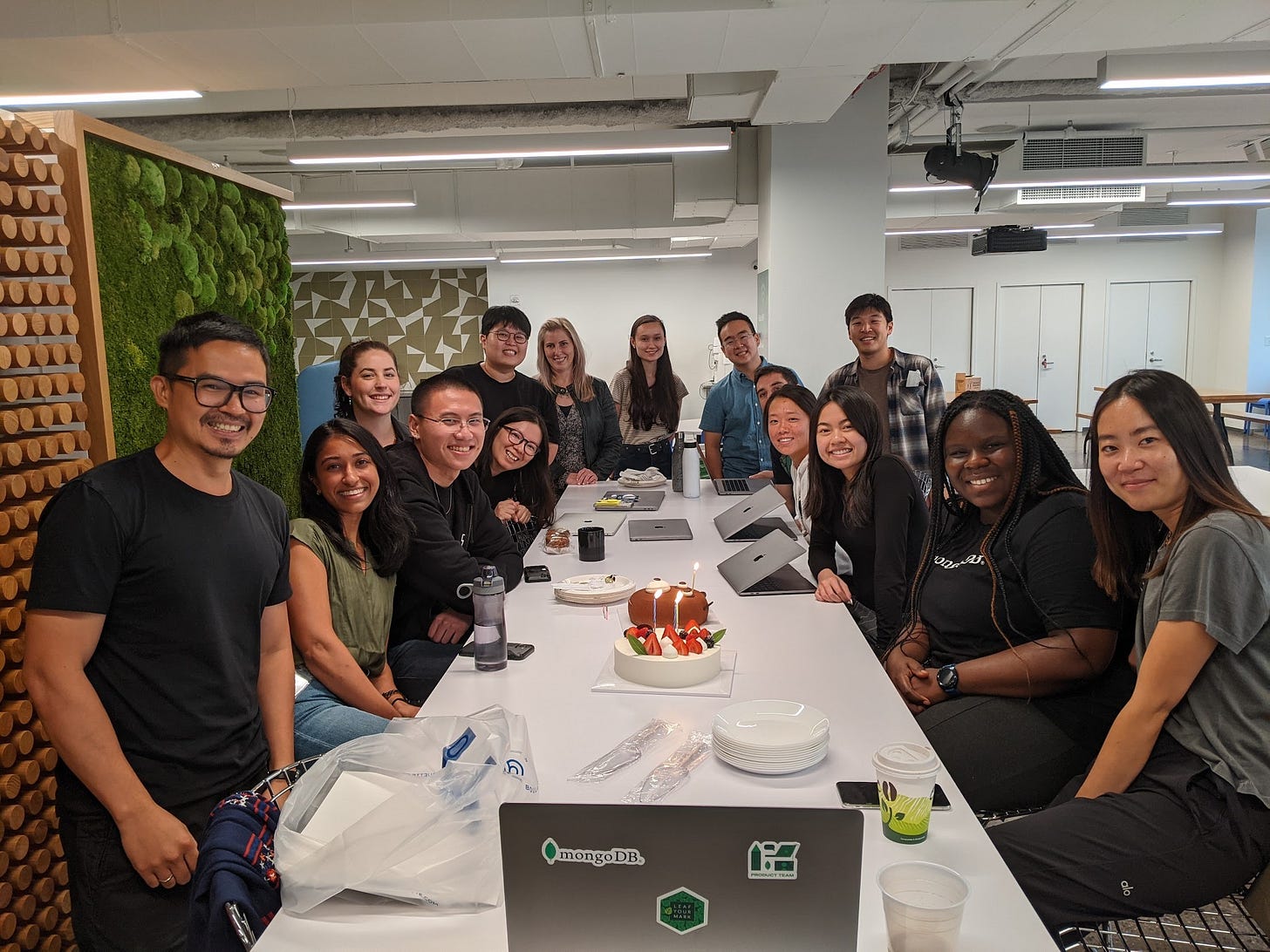Welcome to Design People! We celebrate design people all around the world and share their inspiration, everyday essentials, and important lessons. After reading this, I hope you can learn something or at least smile 😄.
Meet Thomas
Thomas is one of the most kind-hearted and inspiring people I’ve ever had the honor of being around. Get comfy, cozy, and ready to hear his story to design and some real golden nuggets of wisdom.
Thomas’ Design Journey to Present Day
“It really goes back to senior year of high school - when I got my first computer. My neighborhood friends and I got into creating things with different tools like Photoshop, Dreamweaver, and HTML. Somehow, I got really into creating websites and I thought, ‘I like this!’ Because of that thought, I went on to study computer science in college.”
After a little bit of doing and a little bit of not knowing what he was doing, Thomas lost interest in computer science and decided that route wasn’t for him. He then saw a lot of posters for the School of Visual Arts (SVA) and decided maybe design was for him! He put together a portfolio in his free time and made it into SVA’s graphic design program.
“It’s very interesting looking back because even though I’m not doing 100% graphic design, going through design school and the rigorous training prepared me to do well in product design. There were so many lessons I learned that I still remember and do - things like continuous exploration and knowing that your initial ideas are not the great ones so continue exploring. These are the things that I always remember, take with me, and share with my team.”
After graduating, Thomas got his very first job at Shoplet, an office supply company. He was doing everything from working on SEO, optimizing the shopping process, to designing the checkout experience. In Thomas’ words:
“I really appreciate the trust they gave me. I learned so many things and I messed up so many things as well.”
After working at Shoplet for a couple years, Thomas went on to design at Macy’s while working at a small startup on the side.
“Up to this point, I was working on so much random stuff. But, I didn’t know what product design or UX design was. Now, looking back at the work - improving conversion or designing the checkout process - that was all product design. We just didn’t call it that in 2011.”
A few years later, Thomas went on to work at Google as an aptly named interaction designer and focused primarily on his craft. Again, in Thomas’ words:
“I thought I knew what I was doing, but it turned out that I didn’t. I learned so much from my manager and the rest of my team. I focused a lot on my craft, but not so much about product thinking. When I left Google, I realized I definitely needed to do that.”
After Google, Thomas went to work at Goldman Sachs and then Compass. At Compass, he learned so much about product thinking and what a true partnership with product management is. He had the opportunity to work on a collaboration tool for real estate agents and their sellers or buyers. It was here that he got to collaborate with the PMs, brainstorm a vision for the product, mentor other designers, and build up a team.
“It was a small team at first and I made a lot of friends - ones that I still keep in touch with today. I really enjoyed doing the IC (individual contributor) work and making an impact this way. When my manager left though, I ended up taking care of the team in the interim. The more I did that, the more I realized if I was a manager or a lead, I can make a different, maybe even bigger impact.”
Soon after, Thomas saw an opportunity to be a lead at MongoDB. Today, Thomas is a director of product design at MongoDB. What started as an opportunity to lead a small team of 3 turned into the opportunity to lead a team of 10 today.
On Thomas’ Leadership Philosophy
During our talk, Thomas and I spoke a lot about his leadership principles. In short: experimenting and catering.
Catering x Leadership
“I lead leads and ICs of various different levels. Each level is different, but each person is also different. Leads might need more advice, more mentorship. ICs might need also advice, more feedback. You have to find balance too - between fostering autonomy and stepping in. The important thing is to continue finding ways to support them and continue learning how to cater support to each person’s needs - whatever they need.”
Experimenting x Leadership
“Things change all the time - people, challenges, needs. In these times, we need to reset and look at our new environment and update our processes so our partnerships work. This is why I experiment a lot.
For example, at first, I tried the LEAN framework with my team. Then, Dipesh (a design lead on my team) introduced me to another framework and we learned a lot from it. We took away lessons and we iterated. Over time, the framework evolved to fit our needs and is still used today.
Relationships and partnerships are dynamic. They always change. With experimentation, you can adapt and your relationships change from executing projects to solving problems together.”
On Thomas Outside of Design
Funny thing is when I asked Thomas what he does for fun, a lot of the things he mentioned tied back to design. That’s how you know true passion!
Outside of work, Thomas loves reading things. His Google phone sends him recommended content that he always reads. If it’s a great article, he bookmarks it and shares it with his team.

He also loves to exercise, more recently, play pool, and cook. His favorite things to cook: ribs and bread.
“Making bread - there are no shortcuts. It’s like design! Mixing, shaping, letting it rest - there’s a whole process. You have to give it time. Similar to design, you can’t rush it through. You have to explore things.”
☀️ Q&A
Have you ever experienced a design failure or obstacle before? How did you overcome it?
A lot of times! It’s part of life and something that I learn from. For example, in conversations with engineering before, I didn’t try to create a partnership with the engineering team or the product manager (PM). I failed to create a collaborative space and I was left out of many things. I learned we have to change this, engage, drive, and be proactive. We have to not wait for people to include us.
What do you think is the most impactful thing young designers can do to grow their career?
Two pieces of advice:
Find the way you’re comfortable with driving, engaging, and communicating. If you’re an introvert, that’s okay! I am too. Driving and engaging doesn’t always mean speaking out in every conversation or always being the center of attention. There’s other ways. You just have to find ways to drive things to your strengths.
Check how you take feedback. Sometimes, we’re very friendly people and we take feedback too. But, the way you take feedback might not look like it’s received well to others. One time, I even got removed off the project because of how I took feedback. But again, that’s how you learn. Sometimes, you learn the easy way or the hard way. I learned the hard way, but it’s a lesson I took away with me.
What advice do you have for ICs who hope to become leaders one day?
Something my previous manager at Compass shared with me was: you don’t have to be a design manager to be a design leader. You can show your leadership abilities in so many ways.
The way you partner with others or the way you do product thinking and strategy - that’s leadership there. Being so good at your craft that you can show other people or being able to give feedback to someone else - that’s leadership there. Contributing to the design process or calling things out no matter small or big - that’s leadership there. Anything that you can contribute to the greater team is leadership.
Thanks for reading this edition of Design People! If you liked what you read, please consider sharing it with a friend 😄. If you know someone you’d like to see featured next, please let me know!
- Allison







